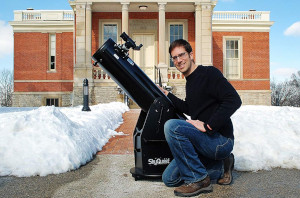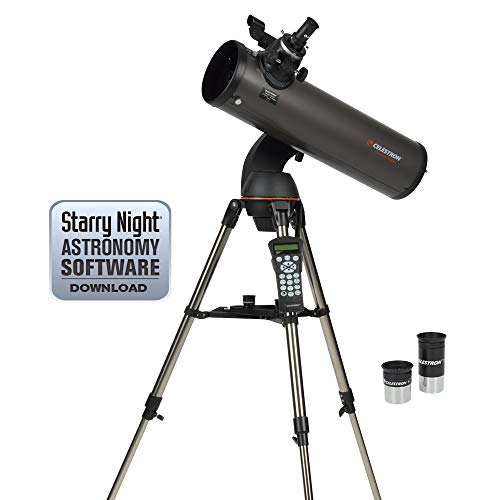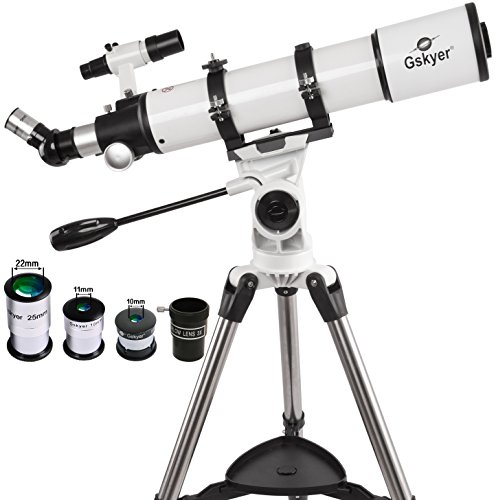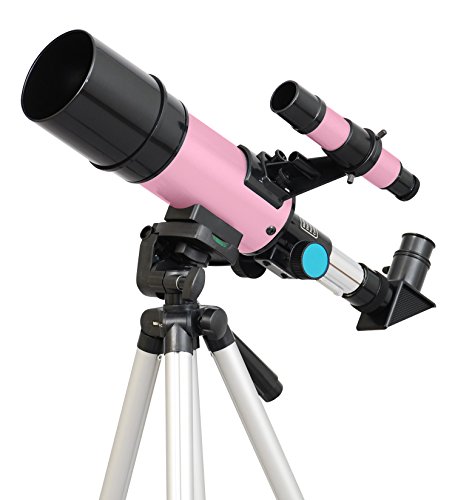5 Best Telescopes Under $500 in 2025 – Reviews & Top Picks
Last Updated on

Many people use telescopes to watch birds or study the stars. Telescopes come in all shapes and sizes and can be extremely expensive. Shopping for one can be complex because of the price and the sheer number of them on the market.
We have reviewed many different scopes that are under $500, so pretty much anyone can afford one. We are going to give you the pros and cons of each so that you get a full picture of each one. We believe that you need to know the good, the bad, and the ugly to make your best decision.

Quick Comparison of our Favorites in 2025
| Image | Product | Details | ||
|---|---|---|---|---|
| Best Overall |
 |
Celestron NexStar |
|
CHECK PRICE |
 |
Orion SkyQuest XT8 Classic Dobsonian |
|
CHECK PRICE | |
| Best Value |
 |
Gskyer AZ90600 |
|
CHECK PRICE |
 |
Orion SpaceProbe |
|
CHECK PRICE | |
 |
TwinStar 60mm |
|
CHECK PRICE |
The 5 Best Telescopes Under $500
1. Celestron NexStar Telescope – Best Overall
The lightweight Celestron NexStar 130SLT Computerized Telescope is our favorite telescope because it offers so much and is easy to use. This compact scope is great whether you are new to astronomy or a novice in the field.
The Celestron NexStar has a high-quality Newtonian reflector that uses the classic mirror telescope design to collect light and reflect it to a focal point.
This telescope attaches to a stainless steel tripod and sets up very quickly. The tripod itself is sturdy, but there is only one point of contact to tighten it down. That one spot is not the strongest and allows the telescope to vibrate with even the slightest breeze. The vibration can make it difficult to focus on your point.
The 130SLT comes with SkyAlign and a StarPointer finderscope to help the alignment process be quick and effortless and get you started doing the fun stuff.
It has a computerized hand control that automatically locates and tracks over 4000 celestial objects. You tell it what you want to see and it points you in the right direction. It gets you close so you can focus on zooming in on that one specific object you’re looking for.
It also comes with “The Sky” astronomy software, which has a ton of information about the sky and maps that you can print out.
This telescope can run on batteries, but it drains them pretty quickly. It is much more efficient if you purchase it with the Celestron power tank or an A/C adapter that you can plug in.
All in all, we think that this is the best telescope under $500.
- High-quality 130mm Newtonian reflector
- Computerized hand control automatically locates and tracks 4000+ celestial objects
- SkyAlign makes alignment fast and easy
- StarPointer finderscope to help with alignment
- Lightweight, compact, and easy to transport
- Sturdy stainless steel tripod
- Includes “The Sky” astronomy software (info about sky & printable maps)
- Weak mount causes vibration
- Batteries not reliable – zap out easily
2. Orion SkyQuest XT8 Classic Dobsonian Telescope
The Orion SkyQuest XT8 Classic Dobsonian Telescope is another great telescope with a large aperture to collect good light, and an eight-inch diameter reflector for that light to reflect off. It has an ultra-stable Dobsonian base that will hold it steady while you observe your point of choice.
The Orion SkyQuest also comes with several accessories. They are nice accessories but are sub-par quality compared to the telescope itself. They include:
- Two-inch Crayford focuser that accepts 1.25-inch and two-inch eyepieces
- 25mm Sirius Plossl eyepiece
- EZ Finder II reflex sight
- Collimation cap
- Starry Night software
This particular scope is our second choice for two reasons. First, it’s extremely big and bulky and isn’t easy to transport from one place to another. It’s best if you have one permanent place to keep it.
Second, it sits pretty low. If you are five-foot-six or taller, you may need to purchase a tripod to lift it up higher. Without it, you’ll be crouching down low and twisting your neck into strange positions to see anything.
- Large aperture
- Eight-inch diameter reflector
- Ultra-stable Dobsonian base
- Many extras
- Big; not easily transportable
- Sub-par accessories
- Sits low; needs tripod
3. Gskyer AZ90600 Telescope – Best Value
The Gskyer AZ90600 Astronomical Refractor Telescope has high-quality optics and includes three high-magnifying lenses, a 24x, 60x, and 120x. It also comes with one 3x Barlow lens that will triple the power of the other three eyepieces. You’ll find an adjustable tripod that will get it up to a height that is comfortable for you, but it doesn’t have a case to carry it in when you transport it.
This telescope is advertised as being easy to use, and that can be true for the experienced astronomer, but it isn’t for beginners. This telescope doesn’t lock into place, so it tends to drift slightly from your focus point. If the finder scope somehow gets misaligned from the main scope, there is no way to adjust it to get them back in alignment.
- High-quality optics: 600mm focal length, 90mm aperture
- High magnification lenses
- Adjustable tripod
- Easy to operate
- Poor quality
- Doesn’t lock into place; drifts
- Not for beginners
- Finder scope not adjustable to align with main scope
- No carrying case
4. Orion SpaceProbe Reflector Telescope
The Orion SpaceProbe 130ST Equatorial Reflector Telescope is a decent telescope with a 5.1-inch aperture. It is only 24 inches long and very lightweight, so it’s easily portable. It has a mount that attaches it to an adjustable tripod, but that tripod is lightweight and not the sturdiest we have ever seen.
When we opened this telescope, it was missing some pieces. According to other reviews, this seems to be a common problem with this product. Once you do finally get all the parts, it’s difficult to put together because the assembly instructions are not good.
After you have put so much energy into assembling this telescope, it’s somewhat frustrating to find that it doesn’t give you the clear, crisp images you desire.
It does have several accessories to help you get the best view possible. They include:
- 1-inch aperture
- Easy portability (24” long & lightweight)
- Sturdy mount and adjustable tripod
- Several accessories
- 5.1-inch aperture
- Easy portability (24” long & lightweight)
- Sturdy mount and adjustable tripod
- Several accessories
- Poor assembly instructions
- Missing pieces
- Almost impossible to collimate
- Bad image quality
- Lightweight mount
5. TwinStar 60mm Refractor Telescope
The TwinStar 60mm Refractor Telescope is a good telescope for kids to start out with to see if they really enjoy stargazing. It is portable and easy for them to use.
You do have to remember that this telescope is for kids and you get what you pay for. It is difficult to focus. It isn’t much more powerful than using a pair of binoculars. The extender tube also flexes with even the slightest touch, which causes a lot of blurry and hazy images.
This telescope also comes with a very short tripod, but it isn’t very good quality. The telescope gets moved with a light breeze.
- Portable
- Easy to use
- Good for kids
- Difficult to focus
- Not very powerful
- Extender tubes flex
- Hazy images
- Not very sturdy

Buyer’s Guide – Choosing the Best Telescope Under $500
Even though you’re looking for a telescope that won’t break your budget, you still want to get the best one you can for the money you have to spend. Below you will find a list of things that are important to know before you begin shopping.
Different Types:
1. Reflector:
Reflector telescopes use a mirror at the back of the telescope to reflect your images. These require more maintenance than refractor telescopes because the optics become misaligned and you have to manually realign them. These telescopes are generally more economical than the other two types.
2. Refractor:
A refractor telescope has a lens at the front of the telescope. The cost of this kind of scope is directly related to how big the lens is. The price goes up as the lens gets bigger. They are pretty straightforward to maintain.
3. Compound:
Compound telescopes use mirrors and lenses to gather the light for your images. They are usually smaller in size and pretty lightweight, so they are easily transportable.
Features:
1. Aperture:
The aperture is the diameter of the primary lens or mirror in the telescope. The larger the aperture, the more light you get. That means you can see objects that are further away, smaller or fainter better.
2. Focal length:
The focal length is the distance between the point where the object is brought into focus and the primary lens or mirror. The focal length tells you how much magnification your telescope is capable of. Be sure that you don’t magnify your object greater than twice the aperture of your telescope in millimeters, or your image will become hazy.
3. Finder:
A finder attaches to the outside of your telescope to help you find what you are looking for without any magnification. Some have red dot technology that will project a red dot into the sky, so you can see where your telescope is pointed with the naked eye. These are great because it can be hard to find where you want to be when you’re looking through the magnification of the telescope. Once you’re in the general area, you can search through the scope to find what you’re specifically looking for.
4. Sturdy mount:
The mount holds your telescope in place so you can get a good focus. If your mount is weak, even a touch or breeze can make it vibrate. Focusing on something with a moving telescope is tough.
5. Steady tripod:
You will want a steady tripod for your telescope, preferably one that is also adjustable for your height.
RELATED: See our favorite telescope that costs less than $300 here

Conclusion:
Now that we have given you information about the different types of telescopes and some features that you will want to look at, here’s another look at our list of what we believe to be the top five telescopes on the market.
1. Celestron NexStar 130SLT Computerized Telescope – Best Overall
2. Orion SkyQuest XT8 Classic Dobsonian Telescope
3. Gskyer AZ90600 Astronomical Refractor Telescope – Best Value
4. Orion SpaceProbe 130ST Equatorial Reflector Telescope
5. TwinStar 60mm Refractor Telescope
We have given you enough information so that you don’t get overwhelmed while shopping for your telescope. Now it’s time for you to make your decision so you can get started on your stargazing journey. We wish you good luck with finding the best telescope under $500!
About the Author Robert Sparks
Robert’s obsession with all things optical started early in life, when his optician father would bring home prototypes for Robert to play with. Nowadays, Robert is dedicated to helping others find the right optics for their needs. His hobbies include astronomy, astrophysics, and model building. Originally from Newark, NJ, he resides in Santa Fe, New Mexico, where the nighttime skies are filled with glittering stars.
Related Articles:
How to Clean a Refractor Telescope: Step-by-Step Guide
How to Clean a Telescope Eyepiece: Step-by-Step Guide
How to Clean a Rifle Scope: 8 Expert Tips
Monocular vs Telescope: Differences Explained (With Pictures)
What Is a Monocular Used For? 8 Common Functions
How to Clean a Telescope Mirror: 8 Expert Tips
Brightfield vs Phase Contrast Microscopy: The Differences Explained
SkyCamHD Drone Review: Pros, Cons, FAQ, & Verdict








